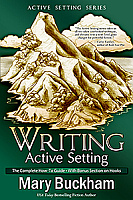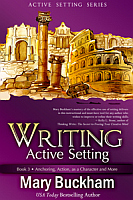I’m still in San Antonio, getting ready for my presentation at the Romance Writers of America National Conference. But don’t worry, USA Today bestselling author Mary Buckham is back with Part Two of her guest post on writing active settings. *smile*
If you missed Part One, be sure to check Tuesday’s post, where Mary shared one of the biggest hurdles to writing great descriptions. She also gave a simple tip to make our Settings come alive for readers.
(Mary is also offering a different giveaway on each post, so don’t miss your chance to comment and enter. We’ll be selecting a name from each post this weekend.)
Today, she’s going to share the second biggest hurdle to writing great descriptions. Yay! Take it away, Mary!
*****
Anchoring Our Settings (& Our Readers)
Have you ever read a book, set it down at the end of a chapter because it was late or time to stop reading and, when you returned to it, you struggled to get back into the story?
Or you’re reading along and are jarred out of the story because you become confused, especially about where the characters are or how much time has passed since a scene or chapter break?
It’s important to never jar a reader, making them suddenly aware that they are in fact reading rather than experiencing.
How do you get around this? Anchoring.
Anchoring, or orienting the reader as to the when and where of the story, is very important to the success of a novel. Anchoring is created when the reader is better able to picture the where and when as well as the who is in the scene and what are they doing at this particular point in the story, which creates a stronger emotional tie by the reader to the character in the story, and thus to the story.
Is Anchoring Really Such a Major Problem?
Since most of us have only read published novels, it’s hard to show how this small craft detail can separate the published from the unpublished, but if you’ve had the chance to read unpublished work for contests, or worked with newer writers, you’ve likely seen this lack of anchoring time and time again. There’s a reason for this lack—two, actually.
#1: What We Imagine Doesn’t End Up on the Page
The first reason, and the most common one, occurs because as we write we can be so deep into the world of our characters that we assume more information is on the page than is really there.
So when we say mountain we assume the reader can see a ten thousand-foot former volcano while the reader may imagine a thousand-foot bump rising out of a flat landscape, or a jagged granite edifice that fronts more mountains such as how one sees the Rocky Mountains if traveling west from the plains. The reader’s vision is based on their knowledge and experience, not on what you’re showing them on the page.
If your character is flying a plane that’s lost power midair and is heading right for the mountain, these interpretations will make a huge difference.
NOTE: Specific details can paint a much clearer and stronger image for the reader than generic, vague details. If your Setting matters to the story, aim for specific, like making that plane heading for the mountain a Cessna 206. If your Setting does not play as large a part in your story—you could be in any small town in any state—the reader still needs to be anchored from chapter to chapter.
#2: Interruptions at Scene and Chapter Breaks
The second most common mistake is forgetting that the reader may have set the book down at the end of the last chapter, or scene, or you have ended a scene in one location and opened the next chapter, or scene, in a new location. Either way the reader needs to get re-oriented quickly so they can slip back into the story world and move forward with the action.
Especially at the beginning of a chapter, or beginning of a new scene, it’s vital to quickly orient the reader as to where the character is, who the character is and how much time has passed since the last chapter or scene.
Why? Because you the author broke the story suspension by breaking the story.
Think of this as a commercial interruption. You have to re-engage the reader back into the story by raising a story question or hook when you left them off and quickly answer the who, what, when, where questions that are raised if there’s any passage of time since they read the previous chapter or scene.
If the reader is struggling too hard to figure out whose point of view they are in (who), has the action changed (what), passage of time (when), or the Setting (where) they are not as engaged in the story itself. The longer this goes on the easier to set the book down again and walk away.
Solutions: How Should We Anchor Our Scenes?
- If there’s no passage in time between the last chapter or scene, echo without repeating the same information in the same way to make it quickly clear time and place have not changed.
Example, a fight ended the last chapter with a hard upper cut to an attacker’s jaw, new chapter starts with the swing that didn’t connect. - If there is a passage of time reveal that within the first 2-3 paragraphs by using change in lighting, quick glance at a clock/watch, or in dialogue.
- If the Setting has changed, reorient the reader with 2-3 sentences of introducing the new Setting—sensory details can help here, as can contrast.
- If the point of view character is the only change reference from the new character something the old character had noticed or interacted with but in a different way.
Bonus Tip for Finding Missing Anchors:
- Give your critique partner or beta reader just the first three paragraphs of your new scene or chapter without the previous one and ask how quickly they were pulled back into the story and, if they weren’t, why not.
*****
Thank you, Mary! This is fantastic information and some great tips! I try to be intentional when writing my setting descriptions, but I need to go check my anchoring at the beginning of each scene.
*makes a mental note to add that to my list of editing items to check*
I especially love the Bonus Tip for how to find those problematic, missing transitions. Thank you so much for sharing!
In Mary’s workshop this past April, she pointed out that the longer we wait to anchor readers at a new scene or chapter, the more confused or disconnected they are. They’ll be looking for any clue to make them feel less adrift, and that means they’re paying less attention to the story. Not good.
 In her Writing Active Setting series, Mary shares tips on subtle ways we can allude to the where (geography, climate, social context, character impression, etc.) and the when (light and shadows, behavior of animals, foreshadowing of events to come, etc.) for our settings.
In her Writing Active Setting series, Mary shares tips on subtle ways we can allude to the where (geography, climate, social context, character impression, etc.) and the when (light and shadows, behavior of animals, foreshadowing of events to come, etc.) for our settings.
She shares tons of examples that illustrate how to put her advice into practice. The complete set includes a chapter on anchoring our settings, as well as chapters on each of the other ways we can make our descriptions work harder and smarter.
*****
 USA Today bestselling author Mary Buckham writes the Amazon best selling WRITING ACTIVE SETTING series (in e-format and now in book form) as well as Urban Fantasy w/attitude.
USA Today bestselling author Mary Buckham writes the Amazon best selling WRITING ACTIVE SETTING series (in e-format and now in book form) as well as Urban Fantasy w/attitude.
Love romance, danger & kick-ass heroines? Find it in her Invisible Recruits series: www.MaryBuckham.com or www.InvisibleRecruits.com.
Writing Active Setting: The Complete How-to Guide with Bonus Section on Hooks Box Set by Mary Buckham in e-book or print versions at your nearest online bookstore!
*****
Mary graciously agreed to hang out in the comments while I’m away, so feel free to ask any questions you have for her. She’ll stop by during the the week and do her best to answer. *smile*

Mary wants to hear from you about whether you’ve ever experienced being disoriented or lost in a story. Have you stopped to ask why? Feel free to share.
As a special treat from Mary, one lucky commenter will win a free e-copy of WRITING ACTIVE SETTING Book 3: Anchoring, Action, as a Character and More! Yay! This is Book Three from her complete series.
Had you heard of this tip to anchor the beginnings of our scenes and chapters? Do you remember to anchor during drafting, or do you need to add this to your editing list (like I do)? Are certain types of transitions harder for you to anchor? Do you struggle with getting the image in your head down on the page? Do you have any tips to add, like how you decide how many (or what kind of) setting details to include?

